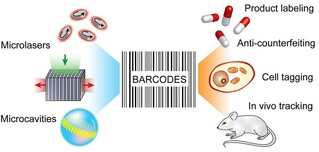Other news

Article in ACS Photonics
Abdur Rehman Anwar, Maruša Mur, and Matjaž Humar from the Department of Condensed Matter Physics F5 have published a review paper in ACS Photonics entitled Microcavity- and Microlaser-Based Optical Barcoding: A Review of Encoding Techniques and Applications. In the paper they review the potential of microcavity- and microlaser-based barcodes for a broad range of applications such as cell tracking, anticounterfeiting, and product labeling. In microcavity-based barcodes the information is encoded in various ways in the properties of the emitted light, most frequently in the spectrum. Spectra of microcavity- and microlaser-based barcodes contain very narrow spectral lines and depend on properties of the microcavity, such as size, shape, and gain material, therefore enabling generation of millions of unique barcodes. Microcavity- and microlaser-based barcoding is a very powerful tool which holds great promise. By developing new kinds of microcavities as well as optical systems for their detection, they could become both a tool in research as well as useful for labeling products in everyday life.
Article inJournal of Physics: Conference Series
Tina Arh, Matjaž Gomilšek, Andrej Zorko, and colleagues from Switzerland have published a paper in the Journal of Physics: Conference Series with the title An experimental procedure to determine quantitative muon Knight shifts about muon spectroscopy experiments. In the paper, they presented a method for more accurate determination of internal fields in a studied sample via simultaneous measurements of the response of a sample and a reference silver plate.
